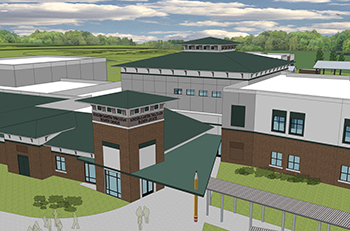St. Johns County’s Newest K–8 Schools Help with Wayfinding
 ST. JOHNS COUNTY, Fla. — Several students in St. Johns County started school on Aug. 18 in new K–8 schools: Patriot Oaks Academy and Valley Ridge Academy.
ST. JOHNS COUNTY, Fla. — Several students in St. Johns County started school on Aug. 18 in new K–8 schools: Patriot Oaks Academy and Valley Ridge Academy.
Construction began early last year on both schools, which together cost more than $21 million. West Palm Beach, Fla.-based Tercilla Courtemanche Architects Inc. (which has since merged with St. Petersburg, Fla.-headquartered Harvard Jolly Architecture) served as the architect on the project, while Jacksonville, Fla.-based Elkins Constructors Inc. was the contractor.
The facilities are part of the St. Johns County School District’s five-year facilities plan. The additional space will help the district accommodate its fast and steady growth in enrollment. This year, an additional 1,168 students are enrolled compared to last year, reported The St. Augustine Record.
“The key to a successful educational design in the 21st century is to provide a well-organized, efficient and secure facility that offers a variety of dynamic environments with maximum flexibility,” said René Tercilla, senior vice president at Harvard Jolly Architecture. “Our children are more apt to strive and achieve higher goals in education if we design schools that are sensitive to the psychological impact, which our buildings create.”
As such, Harvard Jolly Architecture designed both facilities in a way that emphasizes simple wayfinding and creates smaller neighborhoods that help breakdown a potentially overwhelming scale for younger children.
“The breakdown of the facility into smaller neighborhoods also allows us to segregate age groups and strategically organize the circulation to minimize integration between the youngest and oldest students that is sometimes problematic in the K-8 facility model,” Tercilla said.
The design concept is based on a strong central organization where circulation and control originate from secured entrances around the Administration and Media Center core. All academic, arts, physical education and food services extend outward from the core.
“The underlying concept is to keep the circulation as simple and centralized as possible, so the students always maintain a comfortable and secure sense of place within the school facility,” Tercilla said. “The intended consequence is a much simpler school to supervise with fewer staff and a very compact footprint.”
The academic learning environments are divided into four neighborhoods. Each neighborhood incorporates age-appropriate academic and teacher support spaces that integrate the latest in technology, such as teacher voice enhancement and computer projection, Tercilla added.
The individual learning environments are configured with operable sound partitions between pairs of classrooms to allow the flexibility for small-scale collaborative instruction. Each of the neighborhoods incorporates a centralized technology resource center, which can be adapted to facilitate larger-scale collaborative instruction for home economics, art, science or computer technology.
The central core consists of food services, facility support, and all creative and athletic spaces. This includes music, art, a gymnasium, locker rooms, a kitchen, dining, multi-purpose spaces, a stage, storage and central receiving. The grouping of these spaces allows teachers and staff to isolate sections for any after-hours activities. The isolation of these large-volume spaces can also be used for storm-shelter purposes should they be needed.
The prototype design for both facilities also makes use of cost-effective and durable building materials available in today’s educational construction industry, Tercilla added. As such, the design includes a concrete tilt-wall shell protected from the elements by impact-rated windows and doors. The roofing incorporates an aesthetic combination of standing seam metal roofing on light gage metal trusses, and membrane roofing over lightweight insulating concrete on steel bar joist. Interior partitions are proposed to be metal studs clad with gypsum wallboard in a variety of sound-insulation levels determined by space function.
